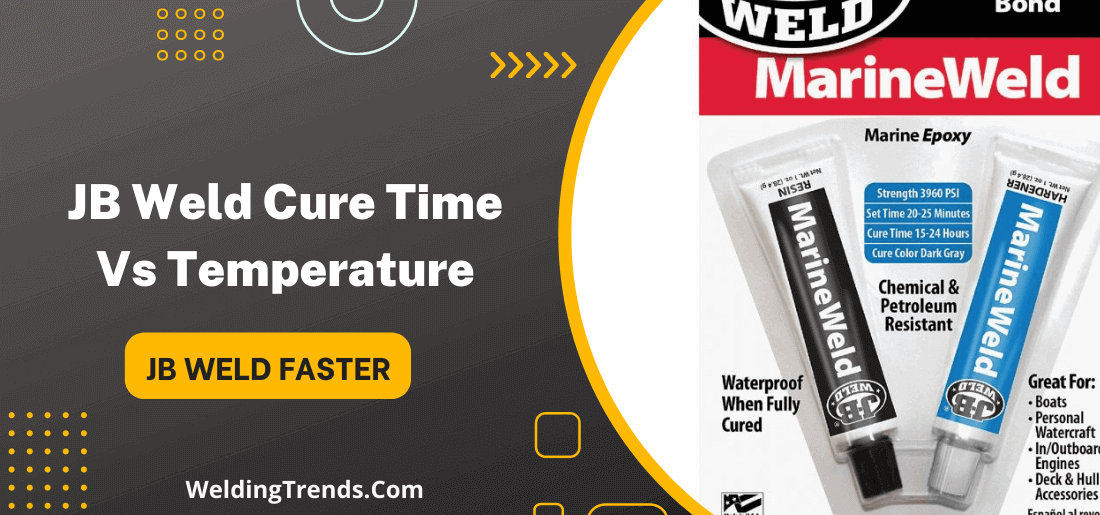When it comes to bonding materials together, there are a variety of methods that can be used. One option is using JB weld.
One of the most important things to consider when using a JB weld is the curing time and temperature. JB Weld cures at different rates depending on the temperature, so it’s important to know what the cure time should be for your specific project.
In this blog post, we’ll take a look at the cure time and temperature requirements for JB Weld. We’ll also discuss some tips on how to speed up the curing process.
What does J-B Weld cure time mean?
The cure time for J-B Weld is the amount of time it takes for the material to harden fully. The cure time will vary depending on the temperature and how thick the layer of the J-B Weld is.
JB Weld cures faster when it is exposed to heat. The ideal curing temperature is between 70-80 degrees Fahrenheit. If you are working in a warmer climate, you can use a hair dryer to speed up the curing process.
For best results, apply a thin layer of J-B Weld to the surface that you are bonding. This will help the material to cure faster and create a stronger bond.
jB weld cure time in cold weather?
JB weld cure time in cold weather can vary depending on the temperature and humidity. In general, JB weld needs about 8 hours to cure at room temperature.
However, if you are working in cold weather, it is best to give the adhesive 24 hours to fully cure. You can speed up the process by using a heat lamp or hair dryer to warm the area where the JB weld is applied.
If you are working in humid conditions, it is important to keep the area well-ventilated to allow the moisture to evaporate and prevent the JB weld from taking too long to cure.
How long does it take jB weld to cure?
JB Weld can take up to 24 hours to cure completely. However, it will be dry to the touch in as little as 4-6 hours and will reach full strength in 14-16 hours.
JB Weld is ideal for bonding most metals including iron, steel, aluminum, brass, bronze and copper. It can also be used on ceramic, glass, and plastic.
For best results, be sure to clean and roughen the surfaces to be bonded before applying the adhesive. JB Weld can be applied to wet surfaces as long as they are cleaned and dried first.
How to make jB weld faster?
By using the following ways you can make your JB Weld cure faster.
- Use a hair dryer or heat gun on its low setting.
- Submerge the area in hot water for about 30 minutes.
- Place a lamp with an incandescent bulb over the repair area for about 3-4 hours.
- Place the object under direct sunlight for about 6-8 hours.
- If you can use an oven, set it to 200 degrees Fahrenheit and place the item on top of a baking sheet. Leave it in there for about an hour or until fully cured.
- If you have access to a microwave, place the item inside and heat it on high for about 3 minutes.
- If you are using JB Weld on a car battery, the easiest way to cure it is to simply start the engine and let it run for about 30 minutes.
- You can also use a UV light to cure JB Weld. Simply place the light about 6-8 inches away from the repair area for 3-4 minutes.
JB Weld Cure Time Vs Temperature
It is important to know the cure time and temperature requirements for JB Weld because the material cures at different rates depending on these two variables.
For example, JB Weld takes four to eight hours to cure at room temperature with a maximum strength of 3960 PSI but only needs six to ten minutes to cure in a preheated oven set at 375 degrees Fahrenheit with a maximum strength of 50000 PSI.
Determining the correct cure time and temperature is essential for getting the full strength out of JB Weld.
If the material is not cured long enough, it will not reach its full potential strength. Likewise, if the cure temperature is too low, the material will not cure properly and will be weaker than it could be.
Does a slower cure mean a stronger bond?
No, not necessarily. A slower cure time can be an indicator of a stronger bond, but it is not a guarantee.
Many factors contribute to the strength of a glue bond, including the type of adhesive, the materials being joined, the surface preparation and the cure time. In general, a slower cure time will result in a stronger bond.
One reason why a slower cure time may create a stronger bond is that it gives the adhesive more time to penetrate the surfaces that are being joined. This penetration can help to improve the grip of the adhesive on the material, which can lead to a stronger overall bond.
Additionally, a slower cure time gives the adhesive more time to form cross-links between the molecules. This type of bonding is extremely strong and is often used in industrial applications.
FAQs – jB weld cure time vs temperature
At what temperature does J-B Weld work?
J-B Weld works best when used at temperatures between 70°F and 85°F. If the temperature is below 70°F, you can preheat the area with a heat gun or hair dryer to improve the adhesion of the J-B Weld.
If the temperature is above 85°F, cooling the area with ice or refrigerant will help improve the bond.
J-B Weld can be used in a wide variety of temperatures, but for best results use it at temperatures between 70°F and 85°F.
Does J-B Weld cure faster with heat?
Yes, J-B Weld will cure faster with heat. However, we do not recommend using a torch on J-B Weld because it can cause the product to discolor. Instead, we recommend using a hair dryer, heat gun or oven to cure J-B Weld.
How long does it take for JB Weld’s high heat to dry?
JB Weld high heat will take approximately 6-8 hours to dry. However, it is recommended that you allow 24 hours for the best results. Why?
Because JB Weld needs time to fully cure and reach its maximum strength. If you can give it that extra time, your repair will be much stronger and last longer.
How long until J-B Weld is waterproof?
It typically takes about 24 hours for J-B Weld to fully cure and become waterproof. However, if you are using the product in a particularly wet or humid environment, it is recommended to allow for a longer curing time.
Additionally, for best results, you should apply a layer of J-B Weld over any exposed metal surfaces before submerging the object in the water.
J-B Weld can withstand constant exposure to water once it has cured, making it an ideal product for repairing leaks or cracked surfaces on boats, pools, and other water-based vehicles.
Can I put JB Weld on a wet surface?
No, you cannot put JB Weld on a wet surface. The material needs a dry, clean surface in order to adhere properly. If the surface is not completely dry, the JB Weld may not set correctly and will not create a strong bond.
Additionally, any dirt or debris on the surface can prevent the JB Weld from bonding correctly. For best results, make sure the surface is clean and dry before applying JB Weld.
What is the best way to apply J-B Weld?
The best way to apply J-B Weld is to follow the instructions on the package.
- First, clean and prepare the surface that you will be bonding with.
- Next, mix equal parts of the J-B Weld resin and hardener. Then, apply the mixed product to one of the surfaces to be bonded.
- Finally, clamp or tape the two surfaces together and let the J-B Weld set for at least 4-6 hours before using.
Final Words
If you’re looking for a strong, durable adhesive that can stand up to high temperatures and cure quickly, JB weld is a perfect choice.
JB Weld is a strong adhesive and can take more than 24 hours to dry completely. Make sure you allow enough time for the adhesive to set before using your repaired object.
JB Weld is a great fix for many things, but drying time can be an issue. If you’re in a hurry, there are ways to speed up the process.
Make sure to follow the manufacturer’s instructions for curing time and temperature so you can be confident your project will be successful. However, you should always test the weld in your specific situation to ensure optimal results.
By following the above guidelines, you can ensure that your JB weld repairs are strong and long lasting.




